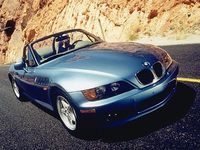New Car/Review
SEE ALSO: BMW Buyer's Guide
1999 BMW Z3 ROADSTER 2.8
By Matt/Bob Hagin
SPECIFICATIONS
Manufacturer's Suggested Retail Price $ 36,770
Price As Tested $ 38,620
Engine Type VVT* DOHC 24-valve 2.8 Liter V6 w/SPFI**
Engine Size 170 cid/2793 cc
Horsepower 193 @ 5300 RPM
Torque (lb-ft) 203 @ 3950 RPM
Wheelbase/Width/Length 96.3"/68.5"/158.5"
Transmission Five-speed manual
Curb Weight 2856 pounds
Fuel Capacity 13.5 gallons
Tires (F/R) 225/50R16 Z-rated
Brakes (F/R) Disc (ABS)/disc (ABS)
Drive Train Front-engine/rear-wheel-drive
Vehicle Type Two-passenger/two-door
Domestic Content 40 percent
Coefficient of Drag (Cd.) 0.32
PERFORMANCE
EPA Economy, miles per gallon
city/highway/average 19/26/22
0-60 MPH 7 seconds
1/4 Mile (E.T.) 15.5 seconds @ 91 mph
Top speed 125 mph
* Variable valve timing
** Sequential port fuel injection
(When BMW first brought out its honest sports car, the Z3, the only reservation enthusiasts had was that the little 1.9 liter four cylinder engine was a bit short on power. Matt and Bob Hagin tried out the updated version, the 2.8, and found that the new one should quiet those critics.)
MATT - The BMW Z3 2.8 is a traditional sports car, Dad. It only seats two people, has minimal luggage space and enough power to pull the doors off most other cars on the highway. The four banger roadster that we tried earlier in the year seemed a little short on pizzazz, although it would go along pretty well if you kept the revs up. But the bigger six-cylinder engine under the hood of the 2.8 version makes a world of difference. It starts to pull really well at engine speeds as low as 1500 RPM and just keeps going hard, clear up to 5300 revs.
BOB - The Z3 with the smaller engine is still being made, Matt, and it's still in great demand around the world. All Z3's are made at the BMW plant in Spartanburg, South Carolina, and I understand that the plant has finally gotten into production of right-hand drive models for England and Japan. When you look at the 1.9 and the 2.8 separately, you can't tell the difference but side-by-side, you can see that the 2.8 is a little bigger all around and that the rear is a couple of inches wider to compensate for a larger axle unit. The suspension and drive train had to be strengthened to compensate for the extra horsepower that the 1999 version of the straight six puts out. The engine is a different unit than the four which is now a 2.3 liter for '99, and is made of aluminum. Another difference between the two is that the six carries a sophisticated variable valve timing system for greater low-speed torque.
MATT - When we tried out the '98 version of the Z3, we neglected to look closely at the creature comforts and amenities that the car offers, Dad. Maybe it's because I'm getting older, but this time around, I was able to appreciate the fact that besides being a road-rocket, the Z3 is a very comfortable touring car. The seats are heated which means that unless the weather is really foul, the driver can enjoy year-round top- down driving in relative comfort. And the manually-operated top on last year's Z3 2.8 has been eliminated for '99 and the power top that was then an option is now standard equipment.
BOB - BMW offers another vintage sports car item, Matt, a removable hard top. These were hot stuff on vintage British sports cars as far back as the late '40s, and on the Z3, it makes the already snug weather protection even more enjoyable. The trunk is definitely not designed for transporting lots of luggage, but the Z3 is targeted towards the buyer who has enough discretionary income to view it as a second car. It won't carry the local soccer team, but the driver and passenger are both going to have lots of fun squirting these cars through mountain roads. The internal appointments are first class, with leather upholstery and controls that are all placed in "natural" locations. Both models have standard air conditioning, of course, and the already good sound system can be upgraded by the dealer with a CD system that handles six discs.
MATT - The 2.8 model has several things that aren't offered on the less-powerful model. Besides the tighter suspension, it can be had with even "sportier" bucket seats that have additional side bolstering, and wider 17-inch wheels that carry 225/45ZR tires in front and 245/45ZR tires in the rear. A limited slip differential is standard, as is an all-weather traction control system that would be very handy on such a performance-oriented car in the snow or on ice. Traditionally, powerful rear-drive cars are a handful to control under slippery conditions.
BOB - BMW can rest assured that I'm not taking their car to the snow. I've found that the stubby design of the Z3 is one that most people either love or hate. The hood with its kidney-shaped grills seems to be an afterthought that doesn't really blend into the nose.
MATT - Dad, when you're driving either of these Z3 "Bimmers" through twisting mountain roads or cruising down a coastal highway with the top down, you don't really think about the design of the hood.



